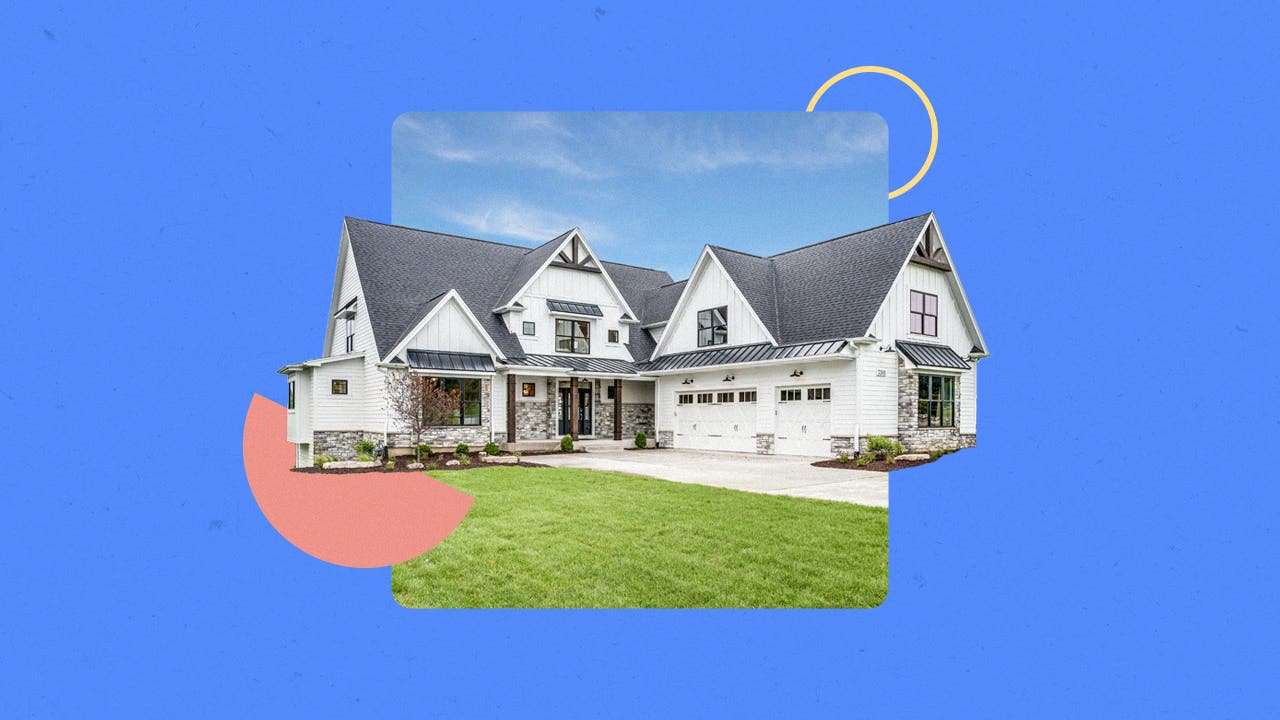Owner financing: What it is and how it works

The Bankrate promise
At Bankrate we strive to help you make smarter financial decisions. While we adhere to strict , this post may contain references to products from our partners. Here's an explanation for .
Key takeaways
- Owner financing is an arrangement in which a homeowner or seller, rather than a bank or mortgage lender, extends credit to a buyer, making the purchase possible.
- Owner financing agreements can be structured in a number of ways, including as a second mortgage, a rent-to-own contract or a wraparound loan.
- Owner financing tends to benefit the seller more than the buyer, but it can be a viable option for buyers who don’t qualify for a traditional mortgage.
If you have few assets, a short or shaky credit history, or low credit score, you might find qualifying for a mortgage difficult — if not impossible. One solution could be owner financing, a unique arrangement that allows you to buy a home without needing to qualify for a traditional mortgage. Here’s what to know.
What is owner financing?
Owner financing, also known as creative financing, typically involves a private arrangement or agreement between the home seller and the buyer. The home seller will provide some or all of the financing directly to the buyer. Most common in transactions involving family members or parties that know each other, the arrangement can involve the full purchase price or just a portion of it.
Example of owner financing
Say a buyer is interested in a home priced at $380,000 and plans to put down $38,000, or 10 percent. Due to credit or financial circumstances, the buyer can only qualify for a mortgage up to $100,000. The seller agrees to finance the outstanding $242,000 at a fixed interest rate for 10 years, with a balloon payment (calculated at a 30-year amortization rate) for the remaining balance due after a decade.
How does owner financing work?
Owner financing can take a variety of forms, including second mortgages, land contracts, rent-to-own agreements and wraparound mortgages. Each of these options has its own specific structure, but all of them involve the property owner acting as the lender.
Rather than giving the buyer a large sum of money to make the purchase, however, the seller usually extends credit, allowing the buyer to make installment payments to the owner to purchase the property. In this scenario, the seller typically retains the deed to the property until the buyer pays for it in full. However, in other cases, the buyer signs a promissory note (the promise to repay the loan) and either a mortgage or a deed of trust (which gives the seller the right to foreclose if the buyer defaults on payments). In exchange, the seller signs a deed transferring title to the buyer.
In most cases, owner financing is a short-term arrangement, lasting five to 10 years (compared to 30 years for a traditional mortgage). And in some cases, the buyer may need to make an upfront deposit.
Types of owner financing
There isn’t just one way to establish an owner financing agreement. Here are some common setups.
Second mortgage
If the buyer only qualifies for a portion of the funds through a traditional mortgage, the seller could extend a second mortgage for the remaining financing, typically with a higher interest rate, a shorter loan term and a lump-sum balloon payment. “Typically, the seller will not hold that mortgage for longer than five or 10 years,” says Chris McDermott, real estate investor, broker and co-founder of Jax Nurses Buy Houses in Jacksonville, Fla. “After that time, the mortgage commonly comes due in the form of a balloon payment owed by the buyer.”
Land contract
In a land contract agreement, the buyer pays the seller directly in installments and receives the deed to the property once they’ve paid the purchase price in full. This approach eliminates the expenses of closing costs and loan-related fees, making it a faster and cheaper option than a traditional mortgage.
Lease-purchase or rent-to-own
In this arrangement, the buyer rents the home with an option to buy at a set price after a certain period of time. When using this approach, some of the monthly rent payments will be applied to the property’s final purchase price. In addition, the buyer typically needs to make an upfront deposit, which will be forfeited if they ultimately decide not to buy.
Wraparound mortgage
If a seller still has a mortgage on the home, they could offer a wraparound loan, meaning the buyer’s mortgage “wraps around” theirs. In effect, the buyer makes payments toward the seller’s mortgage. The seller can charge a higher interest rate on the wraparound and pocket the difference. In this type of arrangement, the seller must first obtain permission from their lender before proceeding.
Reasons for owner financing
Owner financing can benefit buyers who aren’t eligible for a mortgage from a lender, or those who only qualify for some of the financing needed for the purchase. It also gives sellers the opportunity to earn income via interest and, in a buyer’s market, attract more offers.
Here are some scenarios when owner financing can make sense:
- The buyer’s credit or finances aren’t sufficient to qualify for traditional financing.
- The buyer doesn’t have enough for a down payment.
- The home’s purchase price is higher than the lender’s appraised value of it, necessitating the buyer to cover the shortfall with additional funds.
- The parties want to close quickly and/or save on closing costs.
- The parties prefer more flexible terms than what traditional lenders offer.
- The transaction involves a serious fixer-upper or other unique property that traditional lenders aren’t willing to finance.
Pros and cons of owner financing
Owner financing offers much more flexibility for both the buyer and seller, but it’s not without risks.
For a buyer, the main advantage is they “can get a loan they otherwise could not get approved for from a bank, which can be especially beneficial to borrowers who are self-employed or have bad credit,” says Bruce Ailion, a real estate attorney, investor and Realtor with RE/MAX Town & Country in Alpharetta, Georgia.
The big downside: The terms for borrowing the funds might be less advantageous than for a mortgage. And your taking title to the property and building equity in it could be delayed.
Pros and cons for buyers

Pros
- Flexible credit and/or down payment requirements
- No need to apply for a mortgage or undergo underwriting
- Faster and less expensive closing

Cons
- Challenging to find a willing seller
- Higher interest rates and/or a balloon payment, depending on agreement
- Responsible for keeping up with homeowners insurance and property tax payments
- No benefit to credit score/credit history if seller doesn’t report payments
Pros and cons for sellers
The upsides for a seller: the ability to earn more from the buyer’s interest payments and to potentially unload the home as-is, without needing to make repairs.
“Additionally, sellers can obtain tax benefits by deferring any realized capital gains over many years, if they qualify,” says McDermott. “Depending on the interest rate they charge, sellers can get a better rate of return on the money they lend than they would get on many other types of investments.”
The downsides mainly relate to the risk of the buyer not making payments. Also, options to make the arrangement might be limited by your lender, if you’re holding onto your own mortgage.

Pros
- Attract more buyers if offers aren’t coming in
- No need to negotiate offers or pay for repairs
- Faster closing
- Earn income from buyer’s interest payments
- Potential to defer capital gains

Cons
- Risk of loss if the buyer doesn’t pay or damages the property
- Need to vet the buyer yourself
- Costs and burden of drawing up contract and administering the debt
- No or lower proceeds up front to pay off mortgage or buy new home
Requirements for owner financing
The requirements for an owner financing agreement depend on how it’s structured. In general, the terms of the arrangement should be outlined in a promissory note and include the following:
- Promise to pay
- Purchase price
- Down payment amount if applicable
- Interest rate
- Loan amount and term
- Amortization and monthly repayment schedule
- Balloon payment if applicable
- Consequences if buyer fails to pay or pays late
- Homeowners insurance and property tax details
The buyer and seller should each have an attorney review the agreement, at the least, to ensure protections on both sides.
Costs of owner financing
A buyer with owner financing might save some money on closing costs, but there will still be expenses to cover. This includes the cost of a title search and title insurance, which protects the buyer in the event the property has one or more liens on it.
The buyer also typically needs to pay homeowners insurance premiums and property taxes, depending on the agreement. And they will have to be sure to stay on top of them, as they won’t be included in their monthly payments (as they would be with a traditional mortgage).
Tips to buy or sell a home with owner financing
If you can’t get the financing you need from a bank or mortgage lender, an experienced real estate agent can help you find properties for sale with owner financing.
If you’re the seller and don’t already have a buyer lined up, add the owner financing option to your home’s listing description and decide on your non-negotiables.
“Be sure to require a substantial down payment — 15 percent if possible,” says McDermott. “Find out the buyer’s position and exit strategy, and determine what their plan and timeline is. Ultimately, you want to know the buyer will be in the position to pay you off and refinance once your balloon payment is due.”
If you’re on the other end of the transaction as the buyer, it’s crucial to review the agreement with an attorney.
“It’s also a good idea to revisit a seller financing agreement after a few years, especially if interest rates have dropped or your credit score improves — in which case you can refinance with a traditional mortgage and pay off the seller earlier than expected,” says Andrew Swain, co-founder of Sundae, a San Francisco-headquartered residential real estate marketplace for distressed properties.
FAQ
-
If a buyer fails to repay the owner financing, the recourse for a seller depends on the agreement. In a rent-to-own arrangement, for example, the seller might be able to start the eviction process.
-
When using seller financing, the seller does not have to pay taxes on principal repayments made by the buyer. Taxes are only paid on interest income that the seller earns from this type of arrangement. The interest will be taxed by the IRS as ordinary income. For buyers, the tax implications can be slightly more complex and will depend on the specific type of financing arrangement and such factors as the interest rate and length of the loan. Buyers may be able to deduct interest paid on these loans from federal tax returns as they would on a traditional mortgage.
-
One of the easier ways to find an owner-financed home is to search online real estate marketplaces dedicated to these types of properties. If you’re searching with a traditional marketplace like Zillow, try looking at homes listed for sale by owner (FSBO). You could also try searching for a real estate agent experienced in these types of deals.
Related Articles



